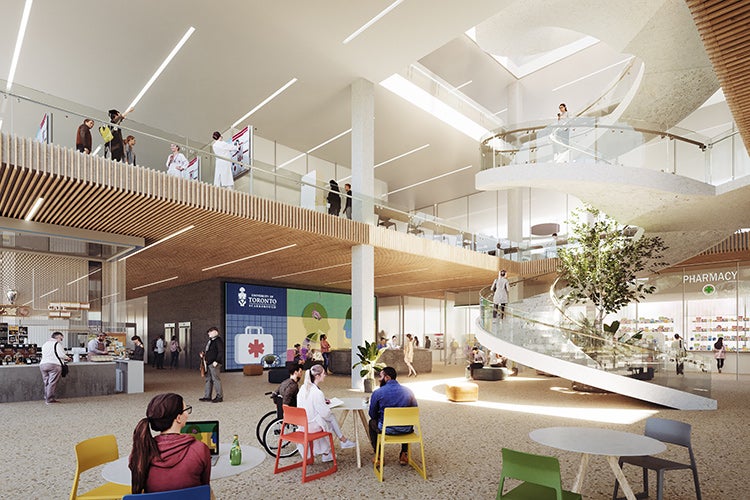
A new medical academy at the University of Toronto Scarborough will fill a critical need by training the next generation of health-care professionals in the eastern Greater Toronto Area.
The (SAMIH) will be a partnership with U of T’s Temerty Faculty of Medicine and Lawrence S. Bloomberg Faculty of Nursing, along with local hospitals and health networks.
Once operational, SAMIH will graduate up to 30 physicians, 30 physician assistants, 30 nurse practitioners, 40 physical therapists and 300 life sciences undergraduates per year. It will also include an expanded life sciences program at U of T Scarborough.
“The new Scarborough Academy of Medicine and Integrated Health will serve the local community, in partnership with neighbour hospitals and community organizations,” says U of T president Meric Gertler.
“It will train the next generation of health professionals, foster innovative scholarly activity, and provide much-needed health and economic benefits to the Eastern GTA.”
SAMIH received funding as part of the Ontario government’s plan to increase the number of doctors in the province, .
“Our government is supporting the University of Toronto with 30 additional undergraduate seats by 2025 and 45 additional postgraduate positions by 2027 at its new Scarborough Academy of Medicine and Integrated Health,” said Jill Dunlop, Ontario’s minister of colleges and universities.
“By planning for these new medical school positions now, students can begin their medical education as soon as the campus opens its doors, meaning more physicians able to join the health care workforce and support this growing, vibrant community.”

SAMIH will graduate up to 30 physicians, 30 physician assistants, 30 nurse practitioners, 40 physical therapists and 300 life sciences undergraduates per year.
SAMIH, which will be the first medical academy in the eastern GTA, will fill a shortage of health-care professionals in the region. According to the Canadian Institute for Health Information, the Central East Local Health Integration Network (where Scarborough and Durham Region are located) has the second lowest number of family physicians and specialists in Ontario per 100,000 residents.
Scarborough is also identified as an area of high physician need by the Ontario Ministry of Health and Long-Term Care. This includes shortages of other specialists such as child and adult psychiatrists, geriatricians, nurse practitioners and emergency medical physicians.
“As one of the top five schools in the world, the Temerty Faculty of Medicine is very well-prepared and able to extend medical education into Scarborough,” says Patricia Houston, acting dean of U of T’s Temerty Faculty of Medicine.
“We’ve had great success in increasing physician capacity and access in Peel and we are confident that investing in U of T’s plans for the Eastern GTA will deliver the equitable, integrated and compassionate care the region needs.”
In addition to serving as a much-needed pipeline to educate students, there will be a particular focus on recruiting from Indigenous and Black communities that are currently underserved.
“SAMIH will address the acute health care needs of our underserved communities in the Eastern GTA by training a comprehensive range of high-quality professionals, many of whom will be talented individuals intentionally drawn from our neighbourhoods and reflecting our diverse communities,” says Wisdom Tettey, U of T vice-president and principal of U of T Scarborough.
Plans also include a new building at the intersection of Morningside Avenue and Military Trail, across from the Toronto Pan Am Sports Centre. The new building, which would serve as a central hub for the academy, is scheduled to open in September 2025 and will accommodate students in various disciplines.
Local partner hospitals and health networks will include the Scarborough Health Network, Lakeridge Health, Ontario Shores Centre for Mental Health Sciences, Sunnybrook Health Sciences Centre and Michael Garron Hospital. There will also be research and teaching partnerships with several local organizations, notably The East Scarborough Storefront, TAIBU Community Health Centre and the Malvern Family Resource Centre.
“There has never been a more critical time to address the unmet health care needs in Scarborough than right now,” says Elizabeth Buller, president and CEO of Scarborough Health Network.
“Establishing the Scarborough Academy of Medicine and Integrated Health at UTSC will create a hub for training and strengthen connections between students and the communities they inhabit.”
Andrew Arifuzzaman, U of T Scarborough’s chief administrative officer, says the Scarborough campus is well positioned to launch the academy due to its location, close ties with the community and connection to U of T’s health sciences programs. It will also help strengthen connections among health-care providers in the region and bring additional economic development and professional employment to Scarborough and the eastern GTA.
With the establishment of SAMIH, U of T’s Lawrence S. Bloomberg Faculty of Nursing will be the only nursing school to have a nurse-practitioner-led clinic as part of its training program, meaning students can provide direct care while under supervision. U of T’s nurse practitioner (NP) program is also the only one in Canada to offer specializations in adult primary care, global health and pediatrics.
“Nurse practitioners are vital to the health of communities,” says Linda Johnston, dean of U of T’s Lawrence S. Bloomberg Faculty of Nursing.
“As part of SAMIH, our NP students will graduate prepared to provide direct care for the community, supporting the greater needs of the health care system in the Scarborough and Durham region.”






